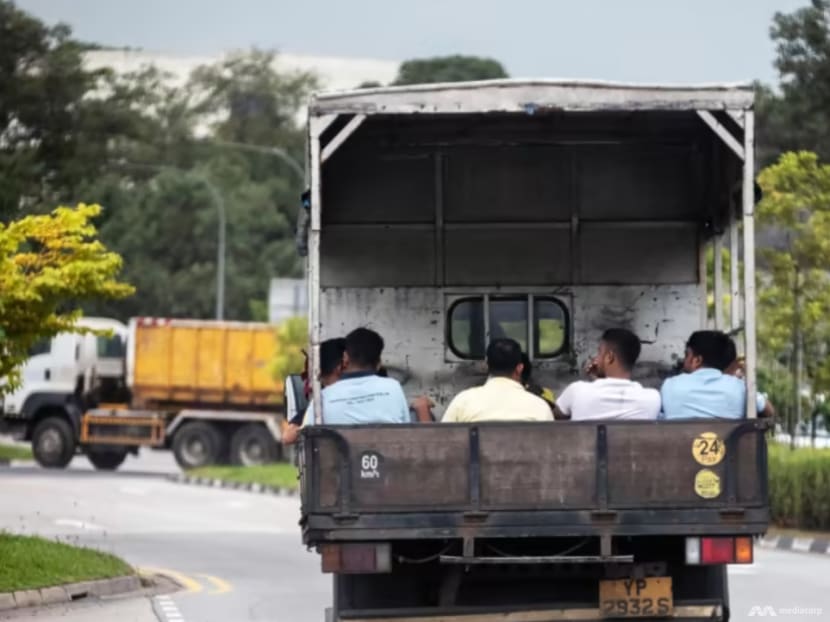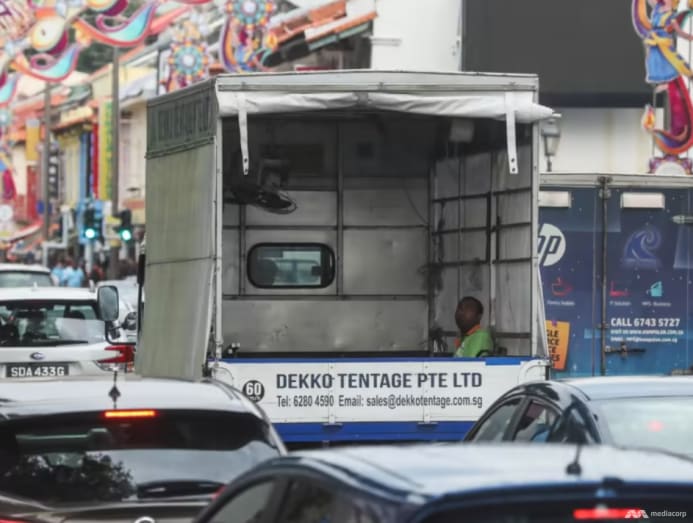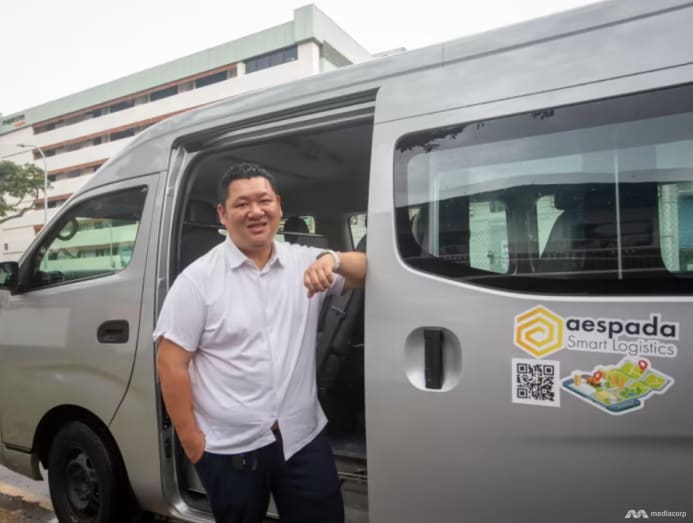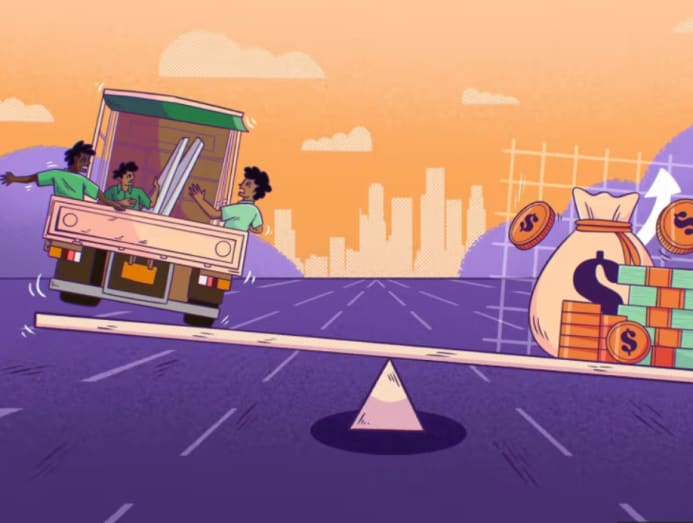The Big Read: Transporting migrant workers on lorries - why can't we stop the unsafe practice after so long?

The long-running debate on the issue of safer transportation for foreign workers was reignited recently. (Photo: TODAY/Ili Nadhirah Mansor)
- The dangerous transport of migrant workers on the back of lorries which has been debated for over a decade was thrust into the spotlight recently
- Companies tell TODAY that that it is not easy to manage the “complexities” of such transport, citing costs, operational needs and infrastructural limitations
- Migrant worker support groups and industry experts meanwhile call for stronger "political will" and a timeline to resolve this safety issue
- Experts also say that there are trade-offs involved and society has to decide who pays the costs — be it financial or social costs
- The stakeholders also give some suggestions on what can be done to move the needle on a practice that has injured thousands of workers
SINGAPORE: Sometime in 2021, migrant worker Miah Mohammad Afzal saw a traffic accident before his very eyes - a motorcycle crashing into a stationary lorry that was picking up a group of his colleagues.
It happened by the roadside where he was waiting with his other colleagues to be picked up by another lorry, which arrived minutes after that accident.
“At that time I was thinking, if this accident happened two minutes later, then I’d also be on the lorry, and I also would have been injured,” he told TODAY, adding that while he felt grateful for narrowly escaping harm, he felt “very sad” for his fellow workers.
Little did he expect that a similar misfortune would befall him just months later, when a car crashed into the lorry that was ferrying him and a colleague as they sat in its rear deck.
While the other man managed to hold on to the side of the vehicle, Mr Afzal, then 28, was flung a few metres out of the lorry.
The accident, which struck Mr Afzal at the prime of his life, resulted in over 250 days of hospitalisation leave and left him with mild cognitive disability and retrograde amnesia, and a permanent injury to his hip and pelvis.
With his mother unwell and the injury claim process dragging out, Mr Afzal returned to his hometown in Bangladesh, where he now tries his best to get by with helping out at his family farm.
“I cannot do hard work like before … Right now, I feel like I’m 40 or 50 years old,” he said, adding that people around him could also notice the decline in his health and ability to do physical work.
Mr Afzal is just one among thousands of workers who have been injured, maimed or killed in accidents involving lorries the past 10 years or so, while the practice of ferrying workers on the rear decks of such vehicles have been endlessly debated on for at least over a decade with nary a progress.

A few other migrant workers who spoke to TODAY recently - mostly under anonymity due to fear of reprisals - lamented how their pleas to employers were met with indifference at best or on many occasions, threats of deportation.
“I cannot open (my) mouth … boss will say: ‘This one, I will send back already,’” said one worker from India who worked as a lorry driver in the construction industry for five years, before recently moving to a different industry. He added that riding on the back of lorries “is not just dangerous, it’s very, very dangerous”.
The long-running debate on the issue of safer transportation for foreign workers was reignited recently, following two such accidents and a parliamentary adjournment motion filed by Member of Parliament (MP) Louis Ng in July, asking for a timeline towards legislating a ban on ferrying workers at the back of lorries, and some interim measures in the meantime.
Two petitions were also raised by members of the public and non-governmental organisations (NGOs) in July, followed by a joint response on Aug 1 by 25 business and trade associations.
While reiterating the business fraternity’s commitment to workers’ safety, the statement cautioned against any form of immediate legislation, warning people to brace themselves for traffic jams, higher costs and “a change in social compact” if they insist on hastily changing the way workers are transported.
The statement inevitably drew flak from members of the public, with some accusing businesses of prioritising profits over human lives, trying to push the bill (and blame) on society, and dragging their feet given that the debate has been going on for so long.
Singapore’s Ambassador-at-Large Tommy Koh also reacted negatively to the statement, saying that the business groups “are resorting to scare tactics to support their cause”.
“We should not be misled by their campaign,” he wrote in a Facebook post.
On the government’s part, the Ministry of Transport (MOT) and government partner agencies issued a joint statement on Aug 2, reaffirming their commitment to workers’ safety while highlighting that a big push that threaten the ability of businesses to stay open may put employees' jobs at risk, besides other “knock-on effects” on society like more expensive or delayed infrastructure projects.
“We want to safeguard both safety and livelihoods of our workers, and have worked closely with stakeholders on a suite of additional safety measures,” the joint statement said, highlighting incremental steps taken over the years.
Amid the renewed debate, a few local companies shared with TODAY the extent of their cost concerns, and other operational challenges they had experienced in trying to switch to safer transport modes.
At the same time, most parties lobbying for better treatment of workers - including NGOs focusing on the welfare of migrant workers - said they empathised with the challenges faced by businesses.
Ms Jewel Yi, co-lead of ground-up movement COVID-19 Migrant Support Coalition (CMSC), acknowledged how difficult it is to be an employer in Singapore and that cost issues would “affect the rice bowls of people on the ground”.
While “we definitely do not and should not demonise” employers in this debate, she stressed that the main point that safe transport proponents are making is “whether the cost concerns of employers should outweigh the lives and limbs of workers”.
While the issue is pressing, and perhaps even overdue, the advocates are not demanding an instant overhaul of the long-running practice.
Instead, the groups are seeking a commitment to a timeline marked by concrete steps - such as greater consultations, pilots and studying various alternative solutions underpinned by a greater political will - so that workers do not have to wait indefinitely in hopes that “complexities” faced by the businesses will be addressed.
HOW FAR HAS THE NEEDLE MOVED?
In the latest Parliament sitting earlier this month, Mr Ng, a People’s Action Party (PAP) MP for Nee Soon GRC, noted how President Halimah Yacob had raised the same issue 14 years ago while she was still a parliamentarian.
Since then, the matter has been raised and debated numerous times.
For example, in the May 2021 parliamentary sittings - after a spate of fatal accidents involving lorries carrying workers - elected MPs from PAP and the opposition Workers’ Party (WP), Non-Constituency MPs from the Progress Singapore Party and Nominated MPs called on the Government to take steps to address the problem.
This year alone, the matter has been raised on multiple occasions - once during the debate on the President’s Address in April and a few more times via parliamentary questions and the adjournment motion by Mr Ng last month.
In terms of actions, the government has introduced a few incremental measures over the years.
These include requiring the front passenger cabin to be fully occupied before the rear deck can be used to carry workers and mandating lorries transporting workers to be fitted with canopies and higher side railings.
“These measures have helped to enhance safety and reduce the risk for workers,” said the authorities in their Aug 2 joint statement.
How can the safety of transporting workers be improved? Listen to the Heart of the Matter:

Related:
The latest round of measures to address these safety risks were implemented in January, in the form of assigned safety buddies and mandatory rest periods for lorry drivers, while the installation of speed limiters on all lorries will be rolled out at a later date.
Migrant worker groups who spoke to TODAY previously were measured in their support of the new initiatives. They highlighted the need for monitoring and enforcement in implementation - notwithstanding the crucial fact that the measures did not address the “inherent” safety risks of transporting workers on the back of lorries.
As of June - half a year since the safety measures came into force - there were 230 injuries and one fatality arising from accidents involving lorries and pickups, according to the latest figures by the Singapore Police Force.
Disregarding the much lower injury numbers for the same half-yearly period during the COVID-19 pandemic (148 in 2022, 173 in 2021 and 91 in 2020), the 2023 figures are at least comparable or higher than some pre-pandemic years (227 in 2019, 224 in 2018 and 205 in 2017).
The publicly available data does not provide a breakdown of the occupations of the victims or on which part of the lorry they were seated in. Law and Home Affairs Minister K Shanmugam said last October in response to a question by WP MP for Sengkang GRC He Ting Ru that the Traffic Police does not track such breakdown in numbers.
The relevant government agencies did not respond to TODAY’s queries in late July this year on possible reasons for the number of injuries showing no significant decrease after the new measures were rolled out, or whether there were enforcement actions being carried out, and what consequences, if any, would errant employers face.
PRIVATE-SECTOR INITIATIVES
Some companies, in the meantime, are doing what they can to make commuting a safer experience for their workers.
Aespada Technologies, a logistics technology start-up, launched an app in 2021 to match construction companies with bus operators, attracting around 25 companies onboard.
Its general manager Shaun Soh told TODAY that, since then, some companies have reverted to using lorries for various reasons, such as an increase in bus services’ prices as demand recovered post-COVID, and the company’s ability to re-hire lorry drivers to fully utilise their existing fleet of lorries.
However, Aespada managed to “maintain the status quo” in terms of its number of clients, with about eight in 10 of them being “big companies”.
“Most of them recognised that their workers feel safer and more energetic when using buses instead of lorries, hence they wish to maintain these benefits for their workers,” said Mr Soh.
“They also realised that it makes more business sense for them to use a bus instead of lorries, especially for main contractors who need to transport 30 workers and above. A bus is more cost-effective than a lorry which has to make two trips.”

Mr Boominathan Veeramani, a migrant worker who works as a lorry driver here, said that there are safety risks for workers sitting on the rear deck, especially those who sit in the middle as they are unable to hold on to the side panels of the lorry.
However, he mitigates such risks to his best ability by driving slowly and carefully, while his company monitors all vehicles’ movement by GPS.
“My boss and my management also can see how fast I'm driving and how far I'm driving. So as per my company management’s request, I drive within the safe speed limit,” he said.
Over at six-year-old main contractor Alexis Construction, the company deploys its 20 workers or so to its various project sites by private-hire car. Materials and equipment are either brought in by its subcontractors or sent via platform delivery services.
“We rented a lorry before, but we felt that the cost was too high - in terms of rental, petrol and so on,” its co-founder John Aston, 40, told TODAY.
He added that as young entrepreneurs - the founders are aged 40 and below - they need to constantly think outside the box to keep costs low.
That was how they arrived at their preferred arrangement now, which costs “way lesser” than the usual industry practice of renting or purchasing their own lorry. Rental for a 14-feet lorry can go for up to S$3,000 (US$2,200) monthly, excluding other expenses such as fuel and driver's salary, he said.

MILLION-DOLLAR BUS RIDE
The main “complexities” — costs, operational needs and infrastructural limitations - that have been highlighted by the authorities and business associations are not easy to manage, several companies told TODAY.
Mr Allan Low, deputy director for quality, environment health and safety at Teambuild Construction Group, said that his company had hired an external bus service to transport some of their workers during the pandemic in 2021, on top of maintaining its fleet of lorries.
He said the bus operator charged about S$3,500 per month for a single 40-seater bus to make two trips a day - between one dormitory and one work site.
If scaled up to ferry Teambuild’s entire workforce of about 1,000 people at that point in time exclusively by bus, the figure could have hypothetically added up to over S$1 million a year.
Mr Low added that other factors such as having different start and end destinations and needing to make multiple trips in a day, along with the rising prices of bus services since then, could push the actual figure higher today, describing the practice as “unsustainable”.
A director in a second generation family business in the construction industry with about 30 workers said that there was no incentive to plough in more money to charter buses or maintain its own fleet “because the customer always demands (the) cheaper option”.
The director, who declined for his or his company’s name to be published over concerns of bad publicity, said these costs will eventually trickle down to consumers.
“Until the day comes when people stop whining about housing prices, the industry will continue to provide cheap housing at tolerated risk levels (by engaging in lower cost practices),” he said.
OPERATIONAL-RELATED CONCERNS
Mr Sanjeev Kumar, project director at Ironhide Demolition & Construction, said that beyond cost concerns are operational considerations.
He has a relatively small team and his workers currently sit in the front cabin of the lorries, which transport equipment and materials to multiple job sites at the same time.
Mr Kumar said that it already takes a long time for the lorry, given current traffic conditions, to reach project sites.
“Imagine if every company were to split this - one is a lorry with equipment and another one is a private bus coming in - it's going to double the traffic congestion.”
Mr Kumar added that this is “not feasible at all” unless roads are widened and traffic is somehow smoothened.
Mr Tay Hing Heng, principal consultant at demolition firm Perisseuo, had offered transport allowance for workers to make their own way to the worksite, though they would be penalised if they were late “so as to make them responsible”.
“(In the end) we gave only one guy S$100 as his transport allowance. The rest took the (lorry) transport because they didn’t want to be responsible for being late,” said Mr Tay, whose company now mainly does consultancy work.
Mr Soh of Aespada said: “Sometimes, (companies) using their own lorry means they can have a longer waiting time for their workers, compared to using buses.”
Shared buses have a stricter schedule with other trips to fulfil, he said, adding that is why some companies have reverted to using their own lorries to have autonomy over their operational scheduling.
BUS DRIVER SHORTAGES
The current shortage of drivers in the private bus sector makes the bus option even more problematic, businesses said.
“Even if bus is the only option should the government mandate the move, we are not able to find (enough) bus drivers or operators taking up the tasks of transporting these workers,” said a spokesperson for a local contractor that declined to be identified.
Agreeing, Mr Kelvin Lim, co-owner of Rae Transport services, said that while bus-driving jobs are plentiful, the main problem is getting drivers.
“Every year, there's a batch of drivers retiring, but (practically) no new drivers come into the market to replace them,” he said.
Mr Zeph Ang, director at bus company A&S Transit, described the manpower shortage as “the worst this industry has faced so far”.
Mr Low of Teambuild said relying on external bus services permanently - especially given the current shortage - would leave his company’s daily operations exposed to uncertainties.
Industry players acknowledged that different companies have different operational requirements, which in turn impact their ability to outsource worker transportation to other parties.
Mr Aston of Alexis Construction, for example, said that he may have to reevaluate alternative transporting arrangements when his company scales up in the future, such as purchasing its own lorry for goods and chartering buses.
“Say if you have 500 workers. Maybe chartering (a bus) might be cheaper than if you own or rent a vehicle and hire a driver, right?” he said.
Meanwhile, some companies, such as maintenance ones, need to make multiple trips throughout the day across different sites - which may cost them more when chartering a vehicle compared to another company that only handles one project site at a time.

BESIDES CONSUMERS, WHO PAYS THE COSTS?
In trying to resolve the issue, there are certainly trade-offs between business considerations and safety measures, experts and NGOs told TODAY.
“But when the trade-off is endangering the lives of migrant workers due to lorries being a fundamentally unsafe way to transport people, we cannot simply acknowledge these difficulties and look the other way,” said a spokesperson from the Humanitarian Organization for Migration Economics, a migrant worker advocacy group.
Sociologist Tan Ern Ser, from the National University of Singapore, said that it remains unclear whether Singaporeans are ready to foot the costs for these trade-offs - be it financial or social costs.
He noted that if this question was raised not long after the pandemic, there was a “high chance” Singaporeans would support it, given the high sense of solidarity with essential workers, including migrant workers, at that time.
“Now that the pandemic is but a memory, the sense of solidarity has somewhat waned,” said Associate Professor Tan.
This is further compounded by high inflation, which would likely make Singaporeans generally “averse to anything which spells increased costs”.
However, Assoc Prof Tan stressed that this was just his personal assessment, and that a focus group could better determine Singaporean attitudes on this issue.
On the issue of financial costs - which has appeared to be the lightning rod in the overall debate - stakeholders have differing views on their importance and how or who should foot the final bill.
Ms Dipa Swaminathan, founder of migrant worker advocacy group ItsRainingRaincoats (IRR), said “whether (cost) is a valid argument or not itself is questionable”, despite it being highlighted prominently by the business community statement.
For example, if one would not allow an employer to get away with not providing insurance for employees for financial reasons, or endanger other groups of workers to cut costs, then one should also disallow ferrying workers in a dangerous transportation arrangement.
Also, granular details like “what exact costs and how much are they talking about” are also unclear, making the argument opaque, she added.
Dr Stephanie Chok, board member of Transient Workers Count Too (TWC2) and Ms Yi of CMSC suggested that the government can use part of the revenue collected from foreign worker levies to subsidise the cost for companies to transition to safer modes of transportation like buses.
“It’ll help to cushion the impact on the companies directly. That will help to get some buy-in, helps to start the process,” said Mr Ng, the MP, referring to the subsidies.
Economist Walter Theseira, from the Singapore University of Social Sciences, pointed out that costs borne by the Government, at the end of the day, will fall on both business and consumers through taxation.
However, he added, one should first determine the final cost.
With a proper timeline, businesses can determine the best and most efficient alternative way to transport workers safely — with some workers taking public transport, some possibly moved to live nearer to project sites and others be transported by buses, or even cutting down manpower for certain businesses, for instance.
“The final cost will likely be lower than what we would expect if we forced everyone to take buses,” said Associate Professor Theseira.
Reverend Ezekiel Tan, president of Hope Initiative Alliance, which is engaged in charity services for the care of migrant workers, noted the importance of taking into consideration the views of all parties.
“(But) we also should try to hasten measures to keep our migrant workers safe,” he said.
“In this regard, we hope businesses can support this matter and be open to critical dialogue and, eventually, good change for all.”
IDEAS FOR SAFER TRANSPORTATION FOR WORKERS
Industry stakeholders largely agreed that shifting all workers from the rear deck of lorries onto buses may not be the most efficient solution to transport workers safely.
Here are some common ideas that the companies and experts highlighted for consideration moving forward:
- Relocating workers
Mr Low from construction firm Teambuild said letting workers stay in construction temporary quarters (CTQs) near to project sites, instead of at far-flung dormitories right now, would greatly reduce the need to ferry them around to begin with.
Assistant professor of business at the Singapore Management University (SMU) Terence Fan highlighted that this would be contingent on the availability of space near the project sites. MP Louis Ng noted one drawback is that such CTQs typically lack facilities compared to purpose-built dorms.
- Resource pooling
Mr Ang of A&S Transit suggested companies whose workers stay at the same dormitory can consider sharing a chartered bus together if their worksites are not too far from each other.
It may be more economically efficient to deploy one bus to pick up one combined group of workers together, than multiple companies each deploying their own lorry. Not to mention it would also reduce the number of vehicles on the road, though it would take a certain degree of coordination and cooperation between firms.
- Government, main contractors leading the way
Some companies, like real estate and construction firm Lendlease, place a clause in their tender contracts stipulating that contractors or suppliers must transport workers safely in buses.
Mr Rakesh Arumugam, country environmental health and safety manager for Singapore at Lendlease, told TODAY: “We do this because we believe that every worker deserves to come to work and go home in a safe and comfortable manner.”
Assoc Prof Theseira said that the public sector is a big customer for construction and public work projects. The Government can “lead the way” in changing industry norms by stipulating higher transport safety standards in tender requirements.
- Progressive implementation
Regardless of the alternative model to be implemented, the stakeholders emphasised the need for it to be done in a progressive manner that minimises disruption while still being guided by a clear timeline.
Mr Ng the MP gave examples of how the Progressive Wage Model and carbon taxes are rolled out progressively, so companies can factor them into their business costs and do advanced planning.
A MATTER OF “POLITICAL WILL”
Having been advocating this issue for years, MP Ng as well as NGOs reiterated that they are not seeking an immediate ban - but for a timeline to be laid out to achieve the eventual goal of not transporting workers in a dangerous manner.
In the meantime, they call for further interim measures, such as reduction of speed limits to 50kmh from 60kmh, forming workgroups which include NGOs to look into the issue together and a further reduction on the number of workers allowed on the back of lorries.
Responding to the call for a timeline, Senior Minister of State for Transport Amy Khor said in Parliament in July: “Setting a timeline without understanding the varied concerns of all stakeholders is also not meaningful or workable.”
When asked about this by TODAY, Mr Ng said in a discernibly exasperated tone, referring to the Transport Ministry: “We’re not talking about a new problem. Surely MOT, in these 14 years, have found out what these complexities are?”
“Maybe your Big Read will solve this, I’ll ask Amy (Khor) if she has read it at the next debate,” he quipped.
Mr Ng acknowledged that steps have been taken over the years, but “more action has to be taken to address the root of the problem”.
“And it’s up to us MPs to push for it,” he said.
A sociologist from the Nanyang Technological University, Associate Professor Laavanya Kathiravelu, said that there is “clear public will to protect migrant lives” even amid the different spectrum of views.
“Rather than wait for some indication of readiness (to bear costs) then, measures could be implemented in the larger public interest, as has been done before,” she said.
Ms Dipa of IRR said that implementing the new measures by stages would also make “more apparent” which areas need support in terms of resources.
TWC2’s Dr Chok said that given its wealth and reputation for “administrative efficacy and urban planning prowess”, “it cannot be” that Singapore is unable to find viable alternatives to transporting workers on the back of lorries.
“We have only been hampered by a lack of political will and the reality is that migrant workers do not have the bargaining power to protest against this trade off, which has been made between lower costs (and lower safety standards) and their lives,” she said.
Meanwhile, thousands of kilometres away back in Bangladesh, Mr Afzal, the victim of the lorry accident, is still grappling with both the physical pain and emotional anguish of not being able to fulfil his dream for his family.
After more than a year following the accident, Mr Afzal finally received an insurance payout of about S$12,000 - less than what he could earn in Singapore in a year when he puts in overtime work.
“I had planned to stay long (in Singapore) and make a nice house. But after this accident ... my life is totally different,” he said.
“Singapore is a very nice country, everything is very good. But this issue … needs to (come to a) close,” Mr Afzal said, adding that no worker likes to be treated “like materials” and being ferried around in the rear of lorries.
“This is not the right way to bring workers, bring people around.”
This article was originally published in TODAY.













